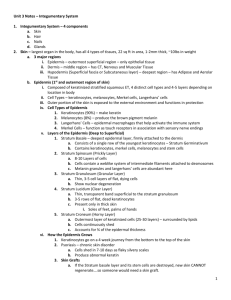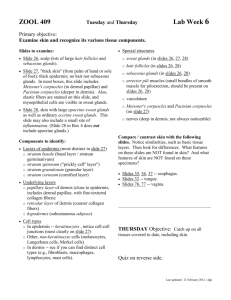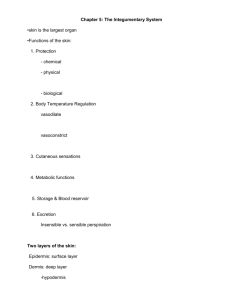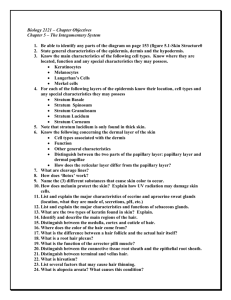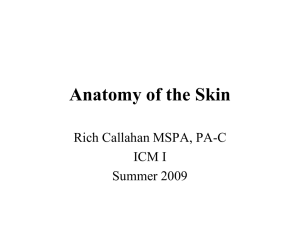physiology and histology of the skin
advertisement
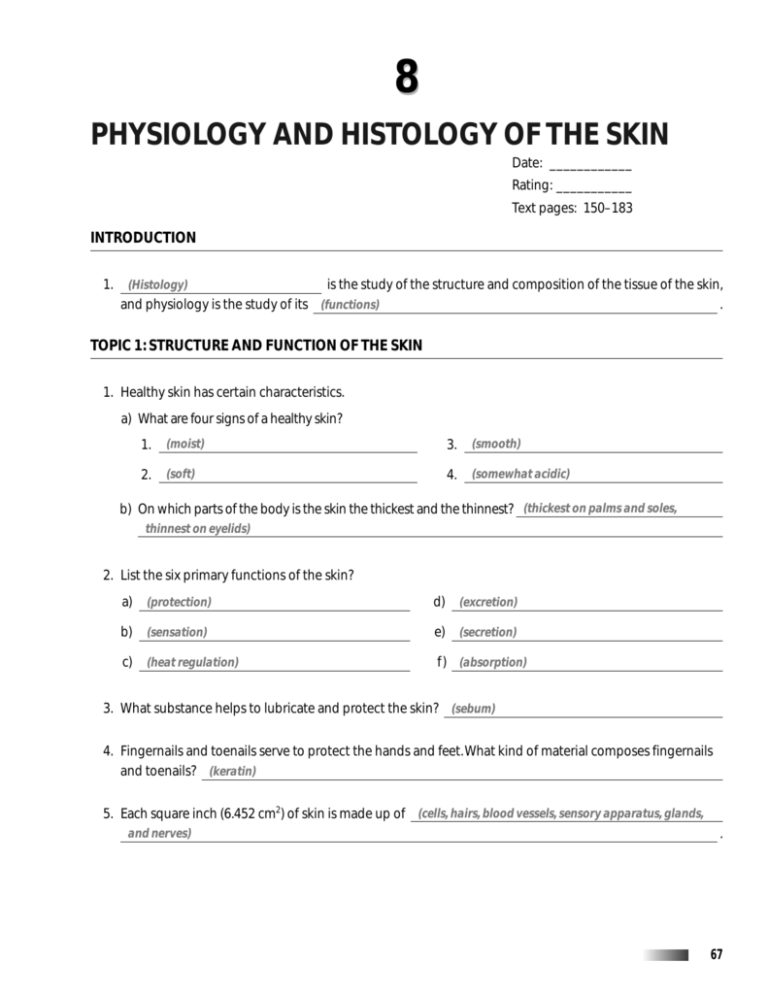
8 PHYSIOLOGY AND HISTOLOGY OF THE SKIN Date: ____________ Rating: ___________ Text pages: 150–183 INTRODUCTION 1. is the study of the structure and composition of the tissue of the skin, and physiology is the study of its (functions) . (Histology) TOPIC 1: STRUCTURE AND FUNCTION OF THE SKIN 1. Healthy skin has certain characteristics. a) What are four signs of a healthy skin? 1. (moist) 3. (smooth) 2. (soft) 4. (somewhat acidic) b) On which parts of the body is the skin the thickest and the thinnest? (thickest on palms and soles, thinnest on eyelids) 2. List the six primary functions of the skin? a) (protection) d) (excretion) b) (sensation) e) (secretion) c) (heat regulation) f) (absorption) 3. What substance helps to lubricate and protect the skin? (sebum) 4. Fingernails and toenails serve to protect the hands and feet. What kind of material composes fingernails and toenails? (keratin) 5. Each square inch (6.452 cm2) of skin is made up of (cells, hairs, blood vessels, sensory apparatus, glands, and nerves) . 67 68 FUNDAMENTALS FOR ESTHETICIANS WORKBOOK WORD REVIEW corneum dermis epidermis keratin melanin pliability protection sebaceous sebum sensation stratum tactile TOPIC 2: HISTOLOGY OF THE SKIN 1. The skin contains two clearly defined divisions, the dermis and the epidermis. a) Which division is the outermost layer? (epidermis) b) Which division is the innermost layer? (dermis) 2. The epidermis is made up of many thin layers. a) How many layers are found in the epidermis? (five) b) Name the epidermal layer that best fits each of the following descriptions: 1. Contains a skin pigment (stratum germinativum) 2. Continually being shed and replaced (stratum corneum) 3. Consists of transparent cells (stratum lucidum) 4. Is known as a granular layer (stratum granulosum) 5. Is known as the spiny layer (stratum spinosum) 3. The dermis of the skin contains two layers. a) Name them. 1. (papillary) 2. (reticular) b) Which dermal layer is directly beneath the epidermis? (papillary) c) In which dermal layer are the following structures and fluids found? 1. Hyaluronic acid (reticular) 2. Looped capillaries and tactile corpuscles (papillary) d) What two protein fibers are found in the deeper layer of the dermis? 1. (collagen) 2. (elastin) 4. a) Where is the subcutaneous layer located? (bottom of the reticular layer) b) The composition of this layer consists of (adipose fat or subcutis tissue) . CHAPTER 8 PHYSIOLOGY AND HISTOLOGY OF THE SKIN 69 5. Name three types of nerve fibers found in the skin and its primary function. a) (Motor nerve fibers—stimulate arrector pili) b) (Sensory—send messages to the brain to react to heat, cold, pain, touch, and pressure) c) (Secretory—regulate excretion of sweat and sebum) 6. a) The skin is indented with natural openings that are called (hair) sebaceous (oil) glands and (pores) follicles with of the sudoriferous (sweat) glands. b) What glands produce sweat that has no offensive odor? (Eccrine) c) Odors and (pheremones) cause a biological reaction to potential mates. 7. Approximately what percent of the skin is water? (50 to 70 percent) 8. To what is the pigment color of the skin attributed? (melanin) 9. The skin functions as an organ of sensation and protection. List five physical sensations that skin reacts to. a) (heat) b) (cold) c) (pain) d) (pressure) e) (touch) 10. What is the general and constant internal temperature of a healthy body? (98.6°F) 11. Match the following definitions. Insert the proper term in the space provided. absorption papillary papillary layer sebaceous stratum corneum a) (stratum germinativum) epidermal layer containing melanin b) (papillary layer) skin layer containing elastic fibers c) (subcutaneous) fatty tissue of the skin d) (stratum corneum) epidermal layer containing keratin e) (papillary) dermal layer containing tactile corpuscles stratum germinativum subcutaneous f ) (sebaceous) glands that secrete protective and lubricating oil g) limited substances that may enter the skin by this process (absorption) 70 FUNDAMENTALS FOR ESTHETICIANS WORKBOOK 12. a) Cells that produce melanin are called (melanocytes) . b) Pigment granules are located in the (basal layer) of the skin. 13. a) What glands produce sweat that has no offensive odor? (eccrine) b) Where on the body will you find a high concentration of these glands? 1. (palms) 2. (forehead) 3. (soles of the feet) 3. (general lifestyle) 14. Aging of the skin is influenced by many factors. a) Name three of these factors below. b) 1. (environment) 2. (health habits) have the greatest impact on how our skin ages. (Ultraviolet rays) WORD REVIEW absorption adipose corneum corpuscle cuticle dermis epidermis excretion Fahrenheit germinativum granulosum keratin lucidum melanin papillary perspiration pigment pliability protection reticular sebaceous sebum secretion sensation stratum subcutaneous sudoriferous RAPID REVIEW TEST Date: _____________ Rating: ____________ Insert the correct term in the space provided. dermis epidermis eyelids largest 1. A healthy complexion is soft and (moist) 2. The skin is the (largest) moist sebum . organ in the body. CHAPTER 8 PHYSIOLOGY AND HISTOLOGY OF THE SKIN 3. The skin is the thinnest on the (eyelids) . 4. The two main divisions of the skin are the (dermis) and the (epidermis) 5. A function of (sebum) From the following descriptive list of parts of the skin, identify the numbered parts on the illustration. Insert the proper term in the space provided. adipose tissue arrector pili muscle arteries capillaries cold receptor epidermic scales hair shaft heat receptor pain receptor papilla papillary layer pressure receptor reticular layer sebaceous duct and gland (hair shaft) 12. (epidermic scales) 13. stratum germinativum sudoriferous duct sudoriferous gland sweat pore touch receptor veins (sweat pore) 2. (stratum germinativum) (papillary layer) 3. 4. (sebaceous duct and gland) 5. (arrector pili muscle) 6. (capillaries) 7. (reticular layer) 8. (papilla) 9. (adipose tissue) 10. (arteries) 11. (veins) . is to lubricate and protect the skin. STRUCTURE OF THE SKIN 1. 71 14. (touch receptor) 15. (cold receptor) 16. (pain receptor) 17. 18. (sudoriferous duct) (heat receptor) 19. (sudoriferous gland) 20. (pressure receptor) 72 FUNDAMENTALS FOR ESTHETICIANS WORKBOOK TOPIC 3: NUTRITION AND THE HEALTH OF THE SKIN 1. Nutrition is the process by which food is assimilated and converted into tissue in living organisms. Healthy skin is dependent upon good nutrition. a) Which two body systems nourish the skin? (blood and lymph) b) How are the nutrients supplied to the skin? (through arteries and capillaries of the circulatory system) 2. The three energy-yielding nutrients include fats, carbohydrates, and proteins. a) Why are some fats important to the body? (produce materials in sebaceous glands to lubricate the skin) b) What is the most important carbohydrate? (glucose) c) Why is glucose important to the body? (It supplies most of the body’s energy.) d) Are sugars and starches proteins or carbohydrates? (carbohydrates) e) What are the chief components of protein? (chains of amino acids) f) Which foods are the main sources of protein? (List at least four) (animal meats, fish, eggs, beans) 3. Energy is measured in terms of heat units. a) What are calories? (a measurement of usable energy) b) What happens to calories that are not used by the body? (The body stores it as body fat.) c) Give an example of a monosaccharide. (fruit sugar) d) Starch is classified as a (polysaccharide) . e) Why are small amounts of cholesterol needed by the body? (Cholesterol is important for cell membranes, and included in the lipid matrix, which comprises the barrier function of the epidermis.) f) An elevated cholesterol level may be present if a client has (white or yellow papules around eyes) . 4. Minerals are required in the structural composition of hard and soft body tissues. Match the correct name of the mineral with the sentence that best describes its function. calcium iron phosphorus potassium magnesium sodium a) (calcium) critical for development and maintenance of bones and teeth b) (magnesium) required for energy release c) (phosphorus) important to the energy metabolism of the cells CHAPTER 8 PHYSIOLOGY AND HISTOLOGY OF THE SKIN d) (potassium) required for energy use and water balance e) (sodium) regulates extracellular fluids. Excessive ingestion can lead to edema f ) (iron) 73 transports oxygen to cells and is a component of red blood cells 5. When vitamins are listed on a label of food, what do the letters “RDA” mean? (recommended dietary allowance) 6. A balanced diet is essential to the health of the entire body and particularly the skin. All vitamins are utilized by the body, but some vitamins are more essential than others for different parts of the body. Match the proper vitamin with the phrase that best describes its importance. vitamins A D K B2 B6 B1 E C a) (A) Severe deficiency of this vitamin may cause night blindness and skin problems. b) (B1) Important for a healthy nervous system and the skin. Helps to prevent beriberi. c) (K) Important to the clotting of blood. d) (B2) Required in energy production by cells. Deficiency can cause cheilosis. e) (C) Required for collagen formation. A lack of this vitamin may lead to poor skin, scurvy, and slow healing. f ) (D) Helps to develop and maintain healthy teeth and bones. g) (E) Protects body from damage caused by free radicals. h) (B6) Connected with protein synthesis, aids in PMS relief. 7. Vitamins are more abundant in some foods than in others. List two or more natural foods that contain an abundance of the following vitamins. a) Vitamin A (carrots, spinach, liver) b) Vitamin B1 (pork, beef, nuts, whole wheat products) c) Vitamin C (citrus fruits, tomatoes, dark green, leafy vegetables) d) Vitamin D (fortified milk, egg yolks, butter) e) Vitamin E (safflower oil, wheat germ, avocados) f ) Vitamin K (beans, spinach, broccoli, egg yolks) g) Folic Acid (asparagus, cantaloupe, sweet potatoes) 74 FUNDAMENTALS FOR ESTHETICIANS WORKBOOK WORD REVIEW absorption amino acids anemia assimilate balanced diet beriberi body processes calories capillaries carbohydrates circulatory system cholesterol collagen connective tissue deficiency dehydration environment enzymes esophagus fats food groups food labels gastric juice glucose inorganic minerals liver lymphatic system malnutrition metabolism minerals molecules night blindness nutrients nutrition organisms pancreas peptide (end bonds) polypeptides protein RDA salivary glands scurvy sebum starch stomach toxic effects toxicity vitamins TOPIC 4: NUTRITION AND ENVIRONMENT—EFFECTS ON THE SKIN 1. a) The use of tobacco can cause damage to the body inside and out. Name three harmful effects of tobacco use to the skin and body functions. 1. (premature aging) 2. (wrinkles) 3. (constricting blood vessels, depriving tissues of oxygen) b) How does the excessive intake of alcohol affect the skin? (List two) (dialates vessels and capillaries, causes dehydration) c) What is the appearance of dehydrated skin? (Dehydrated skin has a dull, dry appearance to the skin.) 2. Water may not be thought of as an element of nutrition, but it is essential to the health of the skin and to efficient functioning of the entire body. a) Approximately how much of the body is made up of water? (50 to 70 percent) b) Name at least four ways water helps to keep the body healthy. 1. (sustains health of cells) 2. (aids in elimination of toxins and waste) CHAPTER 8 3. (helps to regulate body’s temperature) 4. (aids in digestion) PHYSIOLOGY AND HISTOLOGY OF THE SKIN 75 3. The professional esthetician is concerned with the client’s total health, but the main concern is the study of nutrition and its effects on the skin. a) Why is a well-balanced diet essential to the health and beauty of the skin? (gives the body nutrients to feed the skin and heal infections) b) What problems of the skin may be an indication of extremely low-fat diet? (hyperpigmentation and forms of acne) c) Pellagra is a skin disease characterized by a skin rash.What dietary lack is associated with pellagra? (niacin deficiency) 4. a) Proper nutrition is essential for both physical and mental health. What is the best way to ensure a balance of nutrients? (Eat a well-balanced diet getting as many vitamins naturally as you can.) b) What must occur in order to lose weight? (burn more calories than you take in, or take in fewer calories than you burn, or a combination of both) WORD REVIEW alcohol anemia allergies calorie chemical imbalance cholesterol dehydrate dermatitis drugs estrogen jaundice lesions malnutrition mental health nutrition pellagra scurvy skin symptoms temperature tobacco vitamin deficiency water TOPIC 5: METRICS FOR THE ESTHETICIAN 1. Nutrition labeling provides consumers with information about a product’s ingredients, and these ingredients are listed in metric measures. Since the esthetician often recommends products, he or she should know the basics of the metric system. Insert the proper measurement in the space provided. a) (60 drops) 5 ml b) (15 ml) 1 tablespoon (3 teaspoons) c) (one fluid oz) 30 ml (2 tablespoons) d) (60 ml) 4 tablespoons (1/4 cup) 76 FUNDAMENTALS FOR ESTHETICIANS WORKBOOK e) (three fluid oz) 90 ml (6 tablespoons) f ) (120 ml) 8 tablespoons (4 fluid oz) g) 16 tablespoons (.24 liter) (1 cup) 2. When you know the number of teaspoons and multiply by 5, you will find the equivalent in the metric measure milliliters. If you have six teaspoons of liquid, how many milliliters do you have? (30) 3. Water boils at 212° Fahrenheit and at (100°) Celsius. ACTIVITY Chart everything you eat or drink for two weeks. Using the food pyramid (Figure 8–12 in text, page 167) of the recommended daily allowances, categorize your intake with the food groups and recommended servings per day. Do you feel your eating habits are those conducive to healthy mind and body? Did you drink enough water for proper hydration? Where do you need to increase (or decrease) portions to stay within the pyramid? How would you adjust your diet to gain weight? How would you adjust your diet to lose weight?
